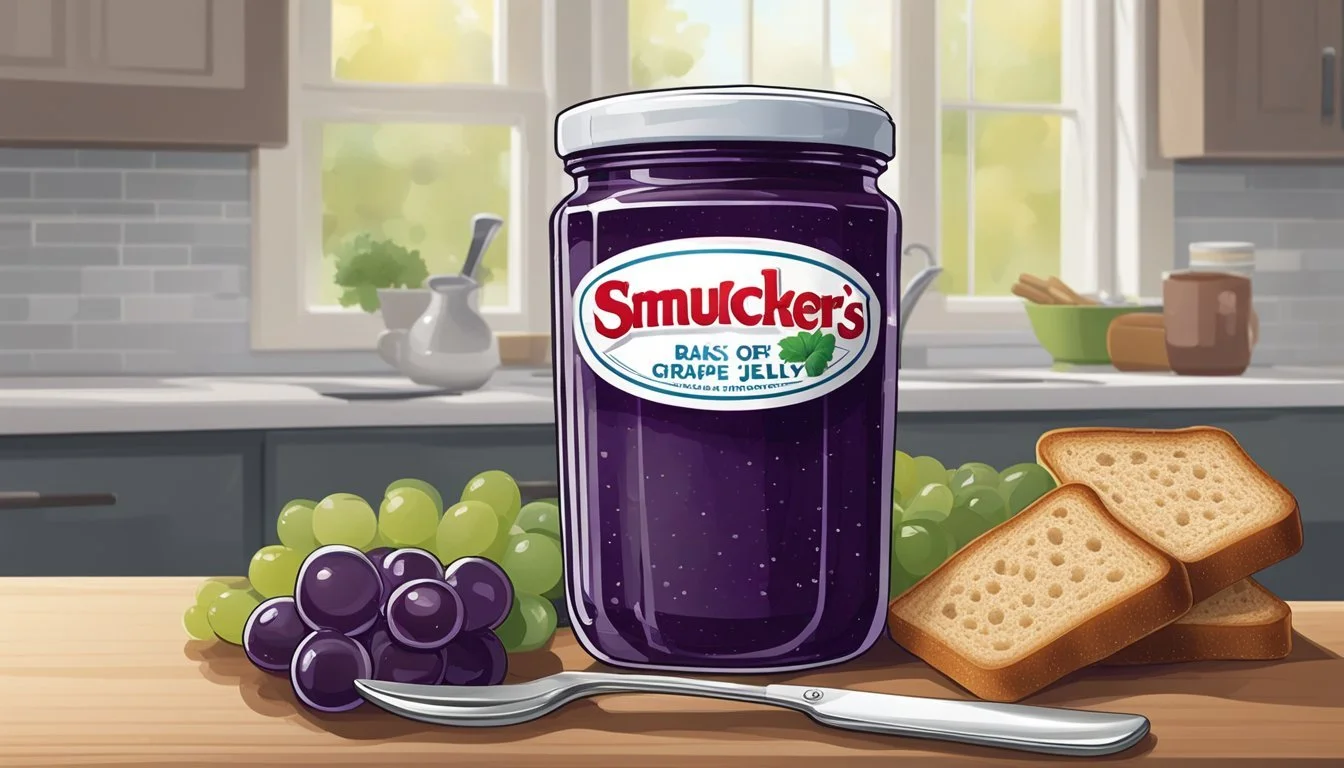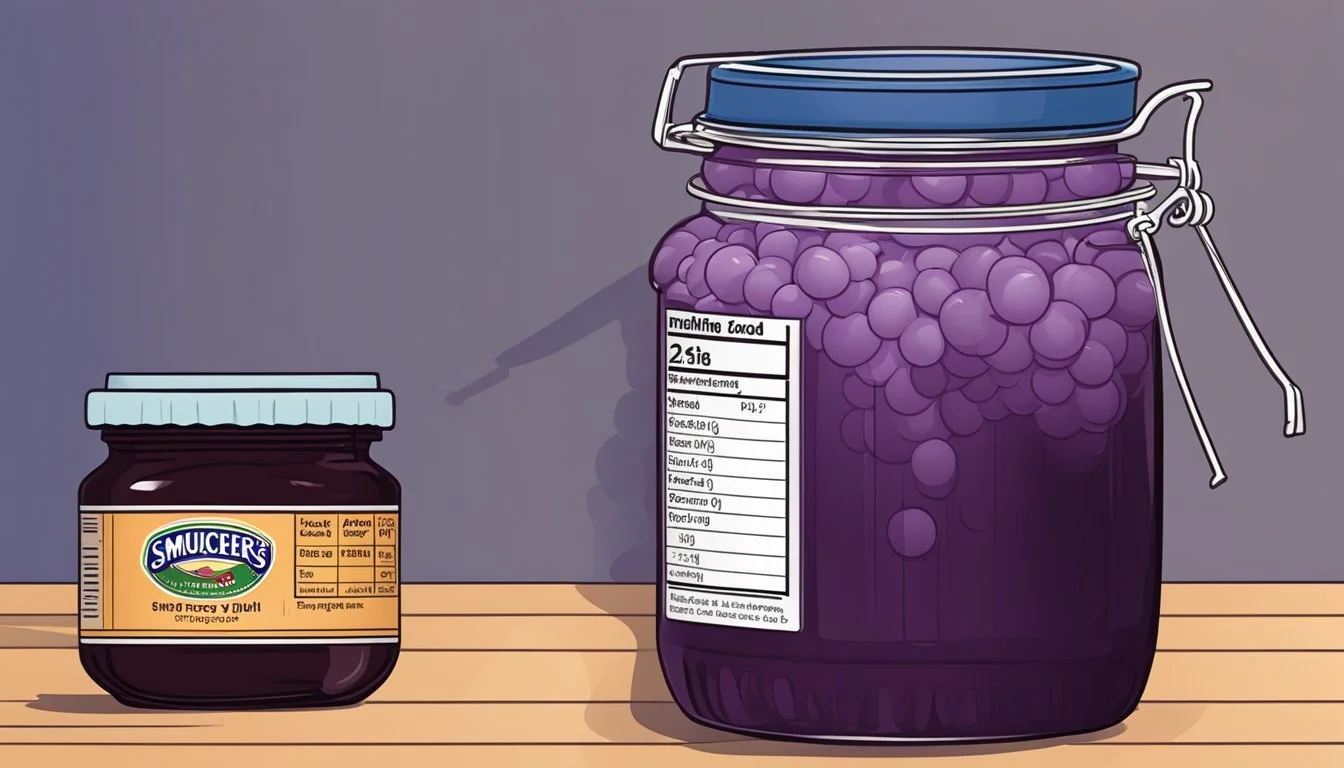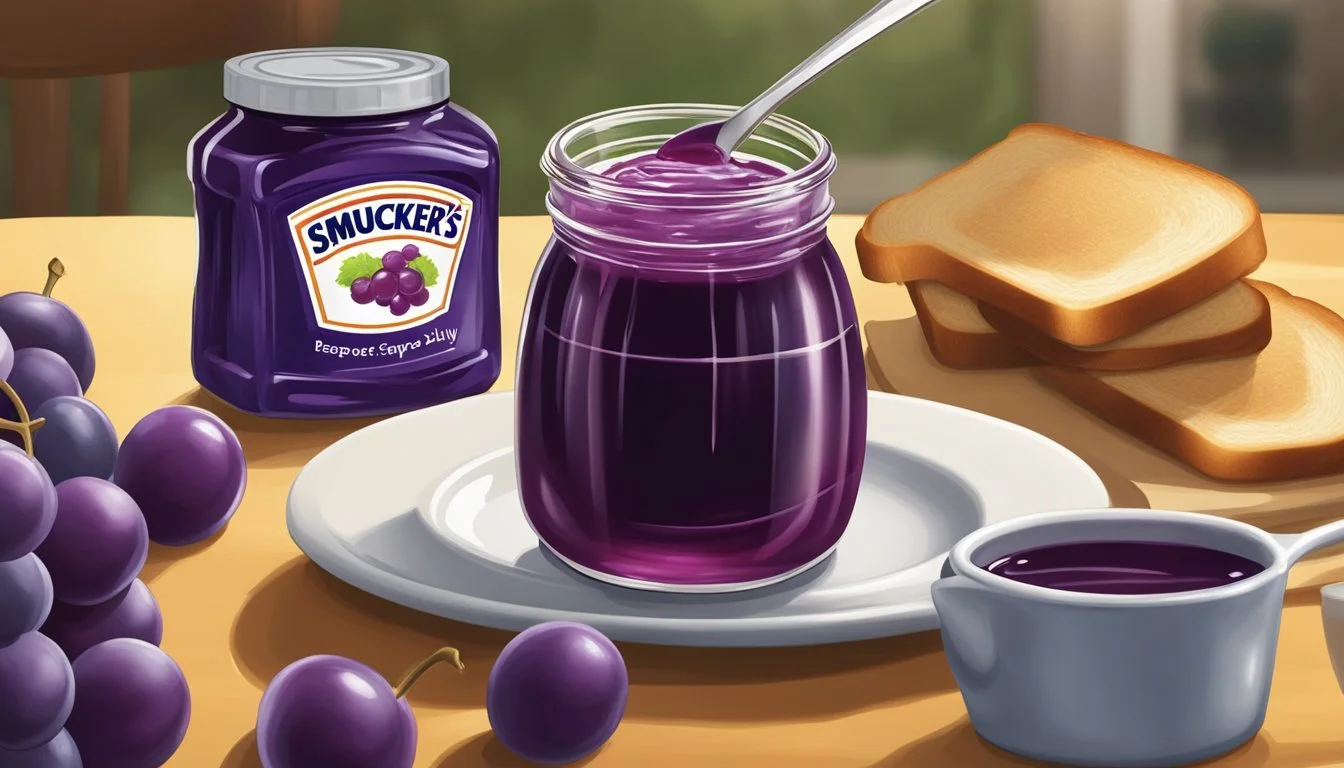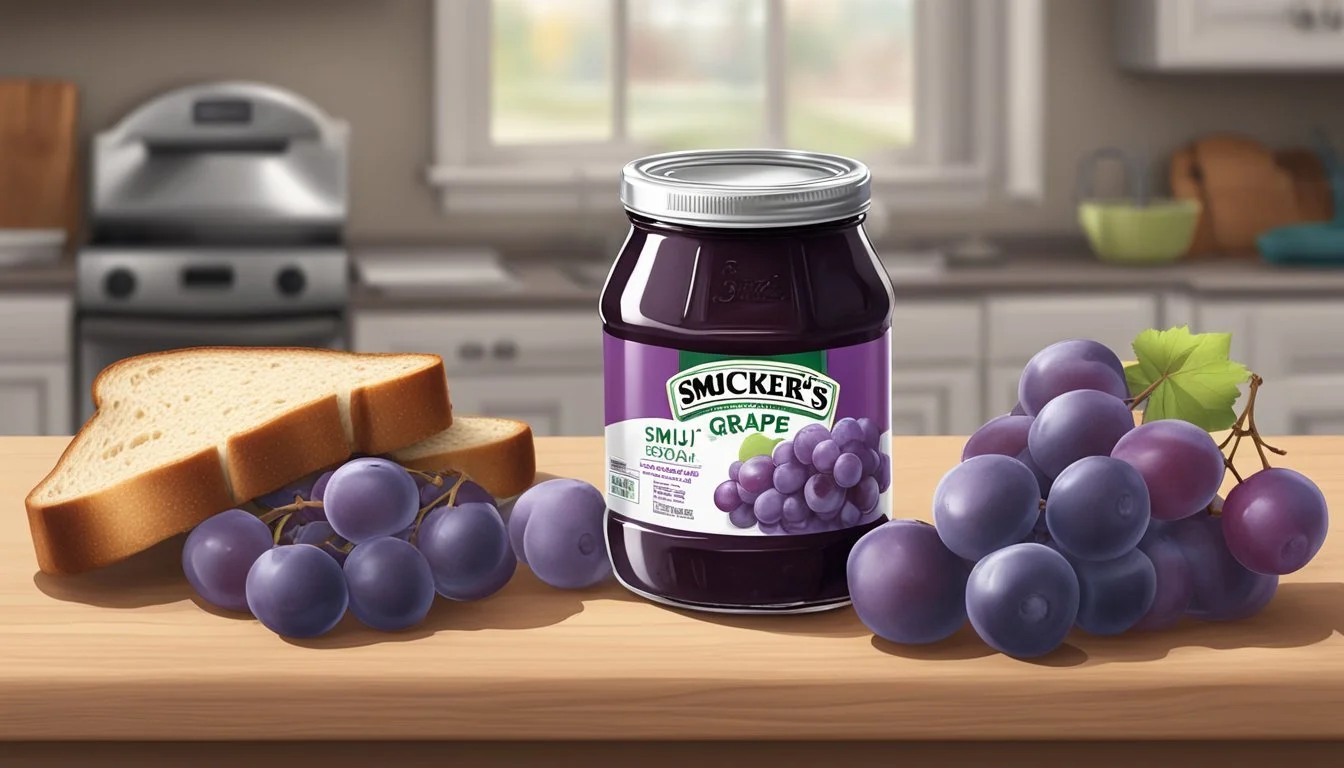How Much Smucker's Grape Jelly Per Day is Excessive
Understanding Limits
Smucker's grape jelly is a staple in many American households, commonly seen paired with peanut butter in a classic PB&J sandwich. This sweet spread, made with grape juice, high fructose corn syrup, corn syrup, and fruit pectin, delivers the familiar taste that generations have grown to love. One tablespoon of Smucker's grape jelly contains 50 calories and 0 grams of fat, making it a relatively low-calorie addition to a meal or snack.
However, moderation is key, as with all sweetened products. Dietary guidelines suggest limiting added sugars to less than 10% of one’s daily caloric intake. Since Smucker's grape jelly includes added sugars, individuals should be mindful of their consumption. Consuming too much grape jelly can contribute to an excessive intake of sugar, potentially leading to health issues such as weight gain, tooth decay, and increased risk of chronic diseases.
The question of how much Smucker's grape jelly per day is too much may vary depending on individual dietary needs and health goals. It is important to consider the jelly within the context of an individual's entire diet. For someone consuming 2,000 calories per day, the American Heart Association recommends no more than 100 calories from added sugar for women and 150 for men, which equates to about 6 to 9 teaspoons, respectively. Hence, it is prudent to enjoy Smucker's grape jelly in moderation, keeping an eye on the overall sugar consumption throughout the day.
Grape Jelly: An Overview
In this section, we’ll explore the specifics of Smucker's Grape Jelly and see how it stacks up against other spreads in terms of nutritional content and usage.
Understanding Smucker's Grape Jelly
Smucker’s is recognized for its variety of jellies, jams, and preserves, with its grape jelly among the most popular. The brand offers Smucker's Concord Grape Jelly as well as Smucker's Squeeze Grape Jelly, both of which provide a traditional grape flavor beloved in many households. Each tablespoon serving of Smucker's Grape Jelly typically contains about 50 calories and 14 grams of sugar, of which a significant portion is added sugar. Despite the sweetness, it contains no fat or protein, consisting almost entirely of carbohydrates.
Grape Jelly vs. Other Spreads
Smucker's grape jelly can be contrasted with other spreads like jams or preserves. Jams are known for retaining more of the fruit pulp, while preserves include chunks of fruit, offering a more textured experience. Compared to other jellies, a portion of Smucker's grape jelly has a similar calorie count but the specific sugar content may vary between different brands and types. For those seeking reduced sugar intake, options like Smucker's Low-Sugar Strawberry Preserves are available with half the calories and reduced sugar content, providing alternatives within the same family of spreads.
Nutritional Profile
Understanding the nutritional content of Smucker's Grape Jelly is essential when considering how much to consume. This section breaks down its calories and macronutrients, as well as the vitamins and minerals present.
Calories and Macros
Smucker's Grape Jelly typically contains 50 calories per tablespoon (20 grams). Consisting almost entirely of carbohydrates, the jelly's caloric content comes from sugars, as it has 0g of fat, 0g of protein, and about 13g of total carbohydrates per serving. It's important to note that these carbohydrates are primarily added sugars, which can impact daily sugar intake limits.
Calories: 50
Total Fat: 0g
Saturated Fat: 0g
Trans Fat: 0g
Cholesterol: 0mg
Sodium: Not specified
Total Carbohydrate: 13g
Dietary Fiber: 0g
Total Sugars: Not specified
Added Sugars: Not specified
Protein: 0g
Vitamins and Minerals
Smucker's Grape Jelly is not a significant source of vitamins or minerals. It lacks notable amounts of vitamin D, calcium, iron, and potassium. Its nutritional value in terms of vitamins and minerals is minimal, making it a poor choice for those looking to increase their intake of these nutrients.
The nutritional information indicates that while Smucker's Grape Jelly can be part of a balanced diet, it should be consumed in moderation, particularly because of its sugar content and lack of essential nutrients.
Dietary Guidelines and Serving Size
Understanding the dietary guidelines and how serving sizes relate to a balanced daily diet is crucial when considering the intake of products like Smucker's Grape Jelly. It is important to account for the jelly's contribution to daily sugar and calorie consumption.
Recommended Daily Intake
The Recommended Dietary Intake (RDI) refers to the daily levels of nutrients considered sufficient to meet the needs of most healthy individuals. While the RDI varies based on age, sex, and level of physical activity, guidelines suggest that added sugars should not exceed 10% of total daily calories. For a standard 2,000-calorie diet, this translates to no more than 200 calories from added sugars, which equates to about 50 grams of sugar per day.
Daily Value (DV): A tool used on nutrition labels to indicate how much of a nutrient one serving of food contributes to a total daily diet. The DV for sugars in a 2,000-calorie diet is typically 50 grams.
Serving Size and Portion Control
Serving size is a standardized amount of food that helps people understand the nutritional content listed on food labels. For Smucker's Grape Jelly, a common serving size is 1 tablespoon (20 grams).
Calories per serving: About 50 calories are found in one tablespoon of Smucker's Grape Jelly.
Total Fat: 0 grams per serving, indicating that it does not contribute to the fat intake in one's diet.
Carbohydrates: Consisting mainly of sugars, it contributes to the daily intake of carbohydrates and should be factored into a food diary or diet regimen, especially when one aims for weight loss or managing calorie intake.
Portion control: is vital for not exceeding the recommended daily sugars and calories. A proper understanding of serving sizes assists individuals in aligning their consumption with their overall dietary goals.
Added Sugars and Health Implications
In assessing the suitability of Smucker's grape jelly in a daily diet, one must consider the sugar content and its health implications. The focus must be on the added sugars that come in forms such as high fructose corn syrup or table sugar. These added sugars can have extensive effects on health, particularly when consumed in large amounts.
Sugar Content Analysis
Smucker's grape jelly contains significant amounts of added sugars. According to the nutritional information provided, one tablespoon (20g) of Smucker's Concord Grape Jelly contains the following:
Nutrient Amount per 1 tbsp (20 g) Total Calories 50 Total Carbs 13 g Added Sugars 9 g
This equates to about 18% of the Daily Value (DV) for added sugars, based on a 2,000 calorie diet. The sugars in this jelly come from both table sugar and corn syrup, which may include high fructose corn syrup.
Health Impact of Added Sugars
Consuming foods with added sugars like high fructose corn syrup can lead to a spike in blood sugar levels. The American Heart Association recommends that men limit their intake of added sugars to 36 grams per day and women to 25 grams per day. Regularly exceeding these amounts can lead to various health issues, such as weight gain, diabetes, and possibly heart disease. Considering the 9g of added sugars per tablespoon of Smucker's Concord Grape Jelly, it is easy to surpass these recommended limits, especially if consumed in multiple servings throughout the day or with other sugary foods and beverages.
Ingredients and Processing
Understanding the ingredients and production methods of Smucker's grape jelly is crucial to assessing its place in a daily diet.
Ingredient List Breakdown
Smucker's Concord Grape Jelly typically contains the following ingredients:
Concord Grape Juice: This is the primary flavor ingredient.
High Fructose Corn Syrup and Corn Syrup: Sweeteners that contribute to the jelly's high sugar content.
Fruit Pectin: A natural gelling agent derived from fruits that helps to set the jelly.
Citric Acid: An acidity regulator that can also add a tart flavor.
Sodium Citrate: A stabilizer that also acts as a preservative.
Processing Techniques
The processing of Smucker's grape jelly involves several steps:
Fruit Preparation: Concord grapes are crushed to extract the juice.
Mixing: The grape juice is mixed with sweeteners (such as high fructose corn syrup and additional corn syrup) and other ingredients.
Heating: The mixture is heated to activate the pectin and to ensure all ingredients are well combined.
Setting: The jelly is allowed to set and achieve the desired consistency through the action of pectin.
Packaging: The final product is packaged into containers for distribution.
It is important to note that this is a simplified overview, and the actual industrial process may include additional steps and considerations to ensure product consistency and safety.
Special Diets and Grape Jelly
When considering grape jelly in the context of special diets, one must consider options that cater to lower sugar intake and align with specific dietary regulations including kosher certification.
Low Sugar Options
For those monitoring sugar consumption, Smucker's Low-Sugar Strawberry Preserves offer a reduced sugar alternative to traditional grape jelly, with only 5 grams of added sugar and 25 calories per serving, as opposed to the standard 50 calories. It's important that these individuals look for jellies labeled as "low-sugar" to ensure they are adhering to their dietary needs.
Diet-Specific Jelly Choices
In the realm of special diets, products like Smucker's grape jelly are often kosher pareve, indicating they meet the requirements of Jewish dietary laws and can be consumed with both meat and dairy.
For pediatric dietary considerations, a pediatric dietitian may recommend specific jelly products that align with children's nutritional needs. Pediatric dietitians can be valuable resources for parents looking to include jelly in a child's diet responsibly.
Utilizing Grape Jelly in Meals
Grape jelly, specifically brands like Smucker's, acts as a versatile staple in kitchens, allowing for both classic combinations and inventive culinary creations. It serves as a sweet component in various dishes, offering a familiar flavor profile that pairs well with contrasting or complementary ingredients.
Traditional Pairings
Traditional uses of grape jelly within meals often revolve around its combination with peanut butter to create the timeless peanut butter and jelly sandwich. The jelly provides a sweet fruitiness that complements the creamy or crunchy texture of peanut butter. A simple layout of a classic PB&J includes:
2 slices of bread (white or whole wheat)
1-2 tablespoons of peanut butter
1-2 tablespoons of Smucker's grape jelly
Another classic pairing is grape jelly with butter on warm toast, scones, or biscuits. Grape jelly can also be incorporated as a sweet contrast in a cheese spread for crackers or used as a glaze for savory dishes that require a touch of sweetness.
Creative Culinary Uses
When one wants to explore creative ways to utilize grape jelly, they might look beyond the sandwich. For instance, grape jelly can be mixed into mayonnaise or chicken salad spread to add a hint of sweetness and depth. Such an application tantalizes the palate and elevates ordinary sandwiches or salad dressings.
Innovative chefs may use grape jelly as a base for sauces, marrying it with tangy ingredients such as balsamic vinegar, creating a glaze perfect for meats like corned beef spread. Here's a quick recipe for a grape jelly glaze:
1/2 cup Smucker's grape jelly
2 tablespoons apple cider vinegar
A pinch of salt and pepper
1 teaspoon mustard (optional)
Heat the ingredients in a saucepan until combined into a glaze consistency.
Additionally, grape jelly can complement spreads like liver spread or black garlic cream cheese spread by providing a sweet counterpoint to their savory notes. Incorporating grape jelly with apple butter can also result in a delightful spread for fall-inspired treats. Another example might include using grape jelly to sweeten red bean spread for a fusion dessert inspired by Asian cuisine.
Technological Aspect of Jelly Consumption
In the context of monitoring jelly consumption, technology offers robust tools for tracking and analyzing dietary intake. Two pivotal components in this technological landscape are food tracking applications and the integration of jelly products into comprehensive food databases.
Food Tracking Applications
A multitude of apps are at consumers' disposal for managing their daily food intake. These applications often feature APIs which allow seamless integration with other health-tracking platforms. A user can input foods they've consumed, such as Smucker's grape jelly, and the app will provide detailed nutritional data. For instance, MyFitnessPal and FatSecret are two popular platforms that enable users to monitor their dietary habits, including the consumption of jelly. They provide features such as:
Food Search: Easy look-up for foods, including a vast variety of jelly types.
Tracking Consumption: Log daily intake and monitor nutrition against personal health goals.
Jelly's Presence in Food Databases
Jelly products are well-represented within food databases, which power the backend of these tracking applications. With the APIs provided by these databases, apps can fetch detailed information about products like Smucker's grape jelly, including calorie content and sugar levels. This information is vital for users who need to understand their consumption levels of specific nutrients. Key features of these databases include:
Recently Popular Foods: Databases keep the information up-to-date, reflecting recent consumption trends.
Comprehensive Nutritional Information: They provide extensive details on food items, down to the micronutrient level.
By offering comprehensive data and ease of access, technology plays a significant role in assisting individuals to maintain a balanced consumption of foods like jelly.
Legal and Commercial Information
In the realm of Smucker's grape jelly, certain legal and commercial aspects such as copyright and trademark rights are vital, alongside the influence of consumer reviews and ratings on product perception.
Copyright and Trademarks
Smucker's grape jelly, as a product, is protected under copyright laws to ensure that the unique formula and brand presentation are not copied without consent. The Smucker's brand, including the logo and product packaging design, is subject to trademark protection. These trademarks act as a signifier of the product's quality and origin and are fiercely safeguarded to prevent market confusion.
The name "Smucker's", the logo, and distinctive product packaging, such as the easily recognizable squeeze bottle, are all trademarked elements. Any unauthorized use of these trademarks can be met with legal action to maintain the integrity and reputation of the brand.
Consumer Reviews and Ratings
Consumer feedback plays a pivotal role in commercial success. Reviews and ratings provide an insight into public opinion, which can directly impact sales. High ratings typically signify customer satisfaction and can lead to increased trust in the Smucker's brand.
Positive reviews can bolster the reputation of Smucker's grape jelly, encouraging new customers to try the product.
Negative feedback, conversely, forces the company to consider product improvements or customer service enhancements.
It is important for companies to monitor and respond to consumer reviews to maintain a positive relationship with their customer base.
Physical Activity and Calorie Expenditure
Understanding the balance between calorie intake and calorie expenditure is crucial in managing how much grape jelly one can enjoy without consuming too much. Physical activities vary in their calorie-burning potential, and incorporating them can help maintain this balance.
Managing Caloric Intake with Exercise
To ensure one can enjoy foods like Smucker's grape jelly without overconsumption, it's essential to engage in physical activities that help burn calories equivalent to or greater than one's intake. For example, a tablespoon of Smucker's grape jelly contains approximately 50 calories. Individuals should aim to engage in exercises that can offset this caloric intake to maintain a balanced diet.
Common Activities and Their Caloric Expenditure:
Walking: A leisurely walk burns about 3.5 calories per minute.
Weight Training: Moderate weight training burns around 3-6 calories per minute.
Cycling: Casual cycling can burn between 4 and 6 calories per minute.
Running Stairs: Vigorous stair climbing can burn over 9 calories per minute.
Running: A moderate-paced run may burn about 9-12 calories per minute, depending on the individual's weight and pace.
Common Physical Activities
The calorie expenditure for various activities depends on factors such as the individual's body weight and intensity of the exercise. Here are some common activities and their approximate caloric burn per minute for a person weighing around 155 pounds:
Activity Calories Burned Per Minute Walking 3.5 Weight Training 3-6 Cycling 4-6 Running Stairs >9 Running 9-12
Regular physical activity not only counterbalances caloric intake from foods like grape jelly but also contributes to overall health and well-being. It is important for individuals to tailor their exercise routines to match their lifestyle and caloric intake for optimum health benefits.












